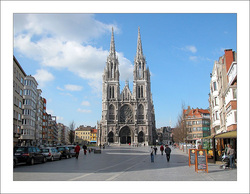Top center of attractions in Oostende

Top center of attractions in Ostende Ostende is a popular Belgian city and municipality situated in the Flemish province if West Flanders. The city is comprised of the boroughs of Mariakerke (West Flanders), Stene and Zandvoorde, and the city of Ostend proper that is largest and the biggest on the Belgian coast. For tourists interest and interaction there are many points and centers of attraction are located close to and around the city. One can approach those centers of attraction either by reaching on foot or by renting a bicycle from the rail station for 9 euro per day. De Lijn bus lines 5, 6, and 39 go along the seafront to the west; if you want to get to points farther along the coast, in either direction, take the Coast Train from a stop next to the rail station. Before making and starting trip to the city be ensured about the fact that you have booked a budget Oostende Hotels for stay in the city. Below are mentioned some of the most popular centers of attraction in Ostende.
• Sint-Petrus-en Pauluskerk: This is a quite massive and illustrative neo-Gothic church founded in 1907 has a suite of stained-glass windows and a memorial chapel as memorial to Belgium's first queen, Marie-Louise of Orleans, who died in Ostend in year 1850.
• Driemaster Mercator: Earlier used to be a Belgian merchant marine training ship, this three-masted schooner now has been converted into a floating maritime museum. It has a length of about 78 meters and a width of about 11 meters. This beautiful ship is indeed is attributed to be visited for having into the tips of the marine warfare.
• James Ensorhuis (James Ensor House): The house is of the Anglo-Belgian artist James Ensor who used to live there in between from 1916 has been restored and there has been transformed into a museum as based upon the life and activities of James Ensor. The Studio and lounge are on the second floor of the building.
• Kunstmuseum aan Zee: Built after the construction of the 2008 merger of the Museum voor Moderne Kunst (Modern Art Museum) and the Museum voor Schone Kunsten (Museum of Fine Arts) it is also known as Mu.ZEE.
• Leopold Park: The Leopold Park interesting was developed as around in 1860 on the old city walls in British style having ponds, paths and flowerbeds. The first park regulations let tourists to have a free access, however, the other way there local residents’ needs to pay about the nominal fee as charged by them. The beautiful bandstand there was inaugurated in year 1885.
• Noordzeeaquarium (North Sea Aquarium): This is a small aquarium with about a collection of fish, mollusks, shell, and crustaceans as from the close and nearby waters of the North Sea. It is quite popular with children as well.
• Sint-Petrus-en Pauluskerk: This is a quite massive and illustrative neo-Gothic church founded in 1907 has a suite of stained-glass windows and a memorial chapel as memorial to Belgium's first queen, Marie-Louise of Orleans, who died in Ostend in year 1850.
• Driemaster Mercator: Earlier used to be a Belgian merchant marine training ship, this three-masted schooner now has been converted into a floating maritime museum. It has a length of about 78 meters and a width of about 11 meters. This beautiful ship is indeed is attributed to be visited for having into the tips of the marine warfare.
• James Ensorhuis (James Ensor House): The house is of the Anglo-Belgian artist James Ensor who used to live there in between from 1916 has been restored and there has been transformed into a museum as based upon the life and activities of James Ensor. The Studio and lounge are on the second floor of the building.
• Kunstmuseum aan Zee: Built after the construction of the 2008 merger of the Museum voor Moderne Kunst (Modern Art Museum) and the Museum voor Schone Kunsten (Museum of Fine Arts) it is also known as Mu.ZEE.
• Leopold Park: The Leopold Park interesting was developed as around in 1860 on the old city walls in British style having ponds, paths and flowerbeds. The first park regulations let tourists to have a free access, however, the other way there local residents’ needs to pay about the nominal fee as charged by them. The beautiful bandstand there was inaugurated in year 1885.
• Noordzeeaquarium (North Sea Aquarium): This is a small aquarium with about a collection of fish, mollusks, shell, and crustaceans as from the close and nearby waters of the North Sea. It is quite popular with children as well.
